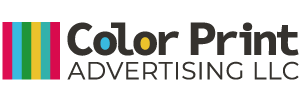No products in the cart.
At Color Print, we believe that creating artwork that translates seamlessly from the digital screen to the printed page is an art in itself. Whether you’re designing business cards, brochures, posters, or any other printed material, the quality of your artwork plays a pivotal role in the final output.
Use High-Resolution Images
One of the fundamental principles of preparing artwork for print is to use high-resolution images. A low-resolution image might look fine on your computer screen, but when printed, it can appear pixelated and blurry. To ensure your images look crisp and vibrant in print, use images with a resolution of at least 300 dots per inch (DPI). This resolution provides the necessary detail and clarity for professional printing.
Choose the Right Color Mode
When creating artwork for print, it’s crucial to use the appropriate color mode. For most print projects, including business cards, brochures, and posters, use the CMYK color mode. CMYK stands for Cyan, Magenta, Yellow, and Key (black), and it is the color mode used in professional printing. Using RGB (Red, Green, Blue), which is typically used for digital screens, can result in color discrepancies between your screen and the printed material.
Pay Attention to Bleed and Trim
Bleed and trim are essential concepts in print design. Bleed refers to extending your design or background color slightly beyond the edge of the document. This ensures that when the printed material is trimmed to its final size, there are no white edges. Typically, a bleed of 3mm to 5mm is sufficient.
Trim, on the other hand, marks the final size of your printed material. It’s crucial to set up your document with the correct trim size to avoid any unexpected cropping of your design.
Maintain Consistent Margins
Consistency in design is key to a polished look. When creating your artwork, be mindful of margins – the space between the edge of the paper and the content of your design. Ensure that text and important elements are within a safe margin, away from the trim line, to prevent them from getting cut off during trimming.
Vector vs. Raster Graphics
Understanding the difference between vector and raster graphics is vital for print design. Vector graphics, created using mathematical formulas, are infinitely scalable without losing quality. They are ideal for logos, icons, and text, as they maintain sharpness regardless of size.
Raster graphics, on the other hand, are made up of pixels and have a fixed resolution. When resizing raster images, you can lose quality and clarity. For print, ensure that images are high-resolution raster graphics or, whenever possible, use vector graphics for the best results.
Mind Typography
Typography is a crucial aspect of print design. Select fonts that are legible and appropriate for your project. Pay attention to font size and leading (line spacing) to ensure readability. Avoid using too many different fonts in a single design, as it can create a cluttered look.
Additionally, outline your fonts before sending your artwork for print. This converts text into vector shapes, preventing any font-related issues during the printing process.
Check Color Consistency
Consistency in color is essential for a professional-looking print. Be sure to use a consistent color profile across all elements in your design. This includes background colors, text, and images. To maintain color accuracy, use color swatches and color management tools within your design software.
Proofread Thoroughly
Before sending your artwork for print, proofread it meticulously. Check for spelling errors, grammatical mistakes, and factual inaccuracies. Once printed, it can be costly and time-consuming to correct such errors.
Consider Paper Selection
Your choice of paper can significantly impact the final look and feel of your printed material. Consider factors like paper weight, finish (matte, gloss, satin), and texture when selecting paper for your project. Different papers can enhance the visual appeal of your design and convey a specific message or brand image.
Test Your Design
Before finalizing your design for print, it’s a good practice to create a test print or request a proof from your printing provider. This allows you to see how your design looks on paper and catch any issues that may have been overlooked in the digital version. Adjustments can be made as needed to ensure the best print quality.
Collaborate with Us
Share your requirements, specifications, and any concerns with us. We offer valuable insights, recommend the best printing techniques, and provide guidance on achieving optimal results.
Save Your Files Properly
When saving your print files, use the appropriate file formats. For most print projects, PDF (Portable Document Format) is the preferred format, as it preserves fonts, images, and layout. Be sure to embed all fonts and include high-resolution images within the PDF.
Sending us your files as a Print Ready PDF is the simplest and quickest method possible. In addition to being full (with no missing links or fonts), PDF files also have true color management, trapping, and open pre-press data. In most cases, a properly exported file is so little that sending it over the internet using our ftp and email services is simple and doesn’t result in any quality or data loss.
We prefer to deal with PDF files, but if you are unable to do so, we can also work with a variety of other file types from software like Word (.doc,.docx), Publisher (.pub), Powerpoint (.ppt), Photoshop (.psd), Illustrator (.ai,.eps), and InDesign (.indd,.idml).
Keep a Record of Specifications
Maintain a record of the specifications used for each print project. This includes details such as color profiles, paper choices, and trim sizes. Having this information readily available can streamline future print projects and ensure consistency in your branding.
Creating artwork for print is both an art and a science. Whether you’re designing promotional materials, business collateral, or personal projects, attention to detail and a commitment to print best practices will help you produce high-quality, professional-looking prints that make a lasting impression. For more information, get in touch with us at sales@colorprint.ae.

